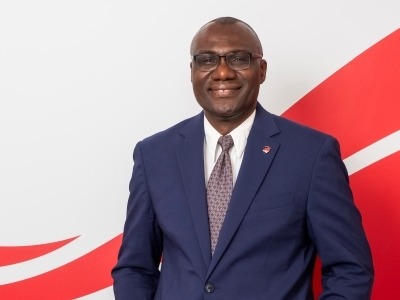From saving peoples’ lives using sensors to more efficient airplanes, Carleton University graduate students are heavily involved in aerospace research.
Aerospace is one of Carleton’s long-standing areas of research strengths. It’s i-Aero collaboration involves 25 faculty researchers across Canada at seven institutions, as well as several graduate students who play a vital role in this kind of research.
Graduate student Derek Ancrum wanted to work on a project that would create more fuel efficient and quieter aircraft. “These are both high priorities in the aerospace industry due to high fuel prices, the desire for airlines to fly larger aircraft into more populated areas with tighter noise restrictions and a focus on passenger comfort,” notes Ancrum. “As this technology develops, it will mean less noise pollution both for people on the ground and within the cabin, and could potentially result in cost savings on airfare.”
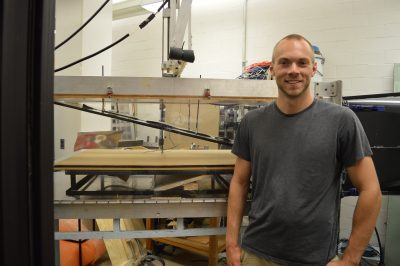
Derek Ancrum
Although a few technologies already exist that are capable of preventing turbulent flow, Ancrum notes that his team’s approach is new. “We are developing a new surface with micro-pillars arranged in rows that will weaken and stop the spread of the turbulent flow by inhibiting the fundamental mechanisms by which the turbulence regenerates itself and spreads.”
Ancrum did an undergraduate degree in Aerospace Engineering at Carleton in which he spent 16 months on a co-op placement in the Flight Sciences Group at the Department of National Defence. Inspired by Engineering Professor Metin Yaras, he decided to pursue a Masters of Applied Science in Aerospace Engineering. Ancrum is also captain of Carleton’s Blackbird UAV which built and flew an unmanned aircraft in the annual Unmanned Systems Canada Student Competition.
“My Master’s has not only been about learning and performing research in aerodynamics, it has been about troubleshooting problems, developing code for data acquisition and processing, learning about instrumentation, building things in the machine shop and countless other experiences that have made me a more well-rounded engineer,” shares Ancrum.
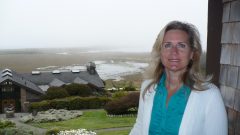
Kathleen Van Benthem
Kathleen Van Benthem, who just graduated this spring with a PhD in Cognitive Science, came to Carleton to work in Dr. Chris Herdman’s Advanced Cognitive Engineering (ACE) lab where they were working on a cognitive health screening tool for older pilots.
“My previous experience as an occupational therapist included extensive work on the issue of older driver safety,” notes Van Benthem, who is now a Postdoctoral Fellow in the ACE Lab. “This experience gave me a good understanding of the importance for older adults to maintain meaningful activities into older age and was, therefore, a natural transition to begin work related to older pilot safety.”
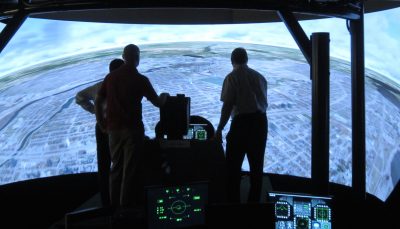
Researchers using a flight simulator in the ACE Lab
About a year ago, Smart Pilot, a project funded by the Canadian Search and Rescue New Initiative Fund (SAR NIF), approached ACE as they were looking to develop resources for older pilots.
Van Benthem says: “They had heard about our work at Carleton and were very pleased to come here and produce four videos based on our findings.”
You can watch those videos by clicking here.
Research at the ACE lab showed that, although older pilots did show poorer results on some aspects of flight performance when compared to younger pilots, some of the effects of age were reduced by having higher levels of expertise. “This emphasizes the need for continued upgrading of skills throughout the pilot lifespan,” says Van Benthem.
Psychology PhD student Chris Nicholson is also doing aerospace research in the ACE Lab.
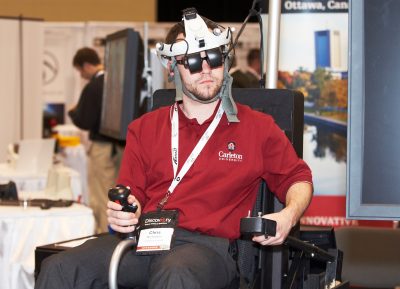
Chris Nicholson
Nicholson’s research focuses on investigating how flight simulator motion affects pilot training.
“Understanding how motion affects training is vital because if we reveal that motion does not improve performance in real aircraft, there is an opportunity to reduce the motion requirements, making simulators more accessible for training,” explains Nicholson. “However, if we find evidence that suggests motion is important for training, we will be able to help our industry partners make informed decisions regarding the implementation of motion in next-generation simulators.”
Rather than trying to link simulator motion directly to flight performance, Nicholson has been examining some common cognitive resources that are used both to pilot an aircraft and process motion information (like that produced by a simulator).
“If there is evidence of some overlap or indication that both tasks are fighting for the same resources, then we can conclude that we should include motion to more actually simulate the cognitive demands of ‘real’ flight in a simulator.”
Ultimately, this research is designed to improve the effectiveness of flight simulators and ultimately improve safety by better preparing pilots for the cognitive demands of operating complex aircraft.
Originally from Egypt, Naglaa ElAgamy says she was lucky to be introduced to Engineering Professor Jeremy Laliberté, whose research interests matched her own.

Naglaa ElAgamy
As part of her PhD in Mechanical Engineering, she is studying the mechanical properties of composite materials which are widely used in the aerospace industry as an alternative to conventional metals.
“Composites are becoming more preferable due to their light weight while providing the equivalent or even superior stiffness compared to metals,” says ElAgamy.
Composite parts on existing aircraft are constantly subjected to stressors that can slowly cause damage in an aircraft. ElAgamy is using a state-of-the-art micro CT scanning unit at Carleton to examine microscopic cracks in composite materials.
She explains: “Commercial software tools are available to simulate the mechanical response of composite parts under various loadings. I work on verifying vital data used for fatigue modelling by analyzing thousands of scanned images, hence developing new modelling techniques, which allow us to predict a part’s mechanical behaviour.”
The i-aero initiative also includes research related to diagnostics, prognostics and health monitoring applications that could eventually have implications for the aerospace industry.
Behzad Yadegari, a PhD student in Electrical and Computer Engineering, has developed a prototype sensing device about the size of a grain of rice that could provide more accurate radiation monitoring for cancer patients. He is continuing to upgrade the sensor to be battery-less, wireless, inexpensive and even more accurate.
Says Yadegari: “This will help minimize the adverse radiation effects on healthy tissues, sparing healthy cells surrounding the tumor.”
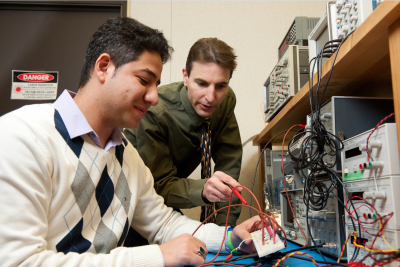
Behzad Yadegari with his supervisor Langis Roy
The miniature wireless X-ray dosimeter that he has developed involves integrated sensors, signal processing electronics, wireless readouts and RFID capability which could be applied to other technologies. For example, the benefits of low power (or self-powering), small size, low cost, and high functionality are of paramount importance to the aerospace industry.
To read more about the research being done by faculty members involved in the i-aero collaboration, please click here.
To find out more about Carleton’s award-winning Faculty of Engineering and Design, click here.
Monday, June 29, 2015 in Grad Student Research, News
Share: Twitter, Facebook
